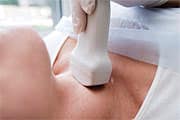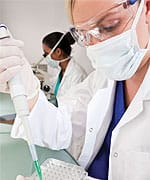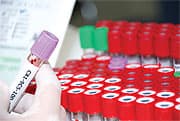Life Extension Magazine®
In 2008, researchers concerned about the growing threat of iodine deficiency analyzed 88 samples1 of iodized table salt—the main supply of this critical micronutrient for most people.2 Less than half of those tested contained amounts of iodine sufficient for optimal health. Coupled with the trend of reduced salt consumption, rates of iodine deficiency are now reaching epidemic levels. In the developed world, iodine deficiency has increased more than fourfold over the past 40 years. Nearly 74% of normal, “healthy” adults may no longer consume enough iodine.3,4 In this article, the latest data on this dangerous trend are presented. You will learn of iodine deficiency’s profound impact on overall health. You will discover iodine’s vital role in thyroid function and its link to obesity, cognitive impairment, heart disease, psychiatric disorders, and various forms of cancer. You will also find out how iodine can help ward off breast cancer and fibrocystic breast disease. What you need to know
Unknowingly Robbing Our BodiesIn nature, iodine is a relatively rare element. It’s found in abundance in the ocean. Its presence in soil, on the other hand, is very low in many places around the world, including the United States. Iodine is essential to life and especially crucial for brain development in children, making its deficiency the number one cause of preventable mental retardation worldwide. It also plays a central role in healthy function of your thyroid gland. This is why the most visible symptom of iodine deficiency is goiter—the unsightly, painful enlargement of the thyroid gland that manifests as an enormous swelling around the neck and larynx.
While goiter was relatively common a few generations ago, most middle age and younger Americans have never seen it. This is largely due to the industry practice of salt iodization in this country, first implemented in the 1920s after the effects of iodine deficiency were recognized and since emulated around the world.2,5,6 (The Morton company was the first to add iodine to salt in 1924, after a successful public health campaign.)7 Unfortunately, as evidenced by recent FDA findings, many table salt makers are now failing to add iodine in quantities sufficient to support optimal health. Other consequences of iodine deficiency, so-called iodine deficiency disorders (IDD), are subtle and may inflict greater damage.6,8 It is estimated that IDDs affect between 800 million and 2 billion people worldwide; reduction in salt intake is likely to drive those numbers still higher.2,9-11 The health benefits of reducing salt intake have been well established.9,12,13 Millions of Americans are slashing their use of salt to protect themselves against high blood pressure and cardiovascular disease. But by cutting our salt intake we are also cutting our iodine intake, which is why mean urinary iodine levels (a measure of iodine sufficiency) plummeted by more than half over a 20-year period.4,14 Additional, otherwise healthy behaviors have also contributed to inadequate iodine intake. (See Table 1.) The danger of low dietary iodine is further compounded by your body’s decreased ability to utilize it, the result of contamination by a ubiquitous environmental toxin called perchlorate. Originally developed for explosives and rocket fuel,18 perchlorate now pervades ground water and food supplies throughout the US. It’s even used as a flavor-enhancer in certain foods.19-21 Perchlorate blocks the thyroid gland’s ability to absorb and utilize dietary iodine, an effect that is of concern when iodine intake drops off.18,22 The US recommended dietary allowance (RDA) for iodine is 150-290 micrograms (mcg) for adults, while the Food and Nutrition Board of the Institute of Medicine has set the tolerable upper limit at 1,100 mcg.18,23,24
These guidelines may be inadequate to address certain health conditions. They were first established as sufficient only to prevent goiter. Daily doses for optimal health of 3,000-6,000 mcg have been used without side effects in studies of people with other iodine deficiency-related health conditions such as polycystic breast disease.18 By way of comparison, the average daily Japanese consumption of iodine ranges from 5,280 to 13,800 mcg of iodine, with no harmful effects and a host of benefits.18,25,26 The Japanese experience is shedding new light on the importance of iodine, not only for thyroid health, but on other body functions as well. In particular, compelling evidence is emerging about the role of iodine in maintaining breast health, a major concern for millions of American women. Since thyroid function is a puzzle to many people, we’ll begin with a brief overview of that important gland and its requirements for iodine. Then we’ll turn to the role of iodine in maintaining breast health, particularly in preventing breast cancer and fibrocystic breast disease. Your Thyroid Gland and the Role of Iodine
Your thyroid gland is located in the front of your neck, just below your voice box. The thyroid produces two forms of thyroid hormone, both of which are derived from the amino acid tyrosine and several atoms of iodine. Thyroid hormones control your body’s metabolism, regulating everything from body temperature and heart rate to glucose consumption and even blood lipid levels.27-29 Too much thyroid hormone (hyperthyroidism) results in an excessively high metabolic rate. People with this condition have rapid heart rates and often palpitations,29 excessive sweating, and may feel much warmer than other people do, even in a cool room. In extreme cases they may lose weight and experience muscle weakness. Too little thyroid hormone (hypothyroidism) results in just the opposite set of symptoms: a slower than normal heart rate,29 a chronic feeling of being cold, constipation, unexplained weight gain, dry skin, hair loss or coarse dry hair, weakness, muscle aches, depression, and fatigue.30,31 In extreme cases, people with low thyroid function experience cognitive decline,32 and babies born to mothers with inadequate iodine levels are at high risk for a unique form of mental retardation known as cretinism. Cognitive impairment caused by low thyroid function is reversible with iodine or thyroid hormone supplementation.32,33 Both over- and under-production of thyroid hormone are associated with the thyroid gland swelling known as goiter. In hyperthyroidism, the goiter is the result of inflammation of the gland as it is under attack by an overactive immune system. In hypothyroidism, the goiter develops as the thyroid attempts to make more thyroid hormone in the absence of sufficient dietary iodine. Iodine deficiency is the most common cause of goiter, and since it causes hypothyroidism, is also the most common endocrine (glandular) problem in the world.18 Iodine deficiency is most prevalent in people who live far inland, away from the oceans that provide our best source of iodine. Those areas are commonly referred to as “goiter belts,” because of the high rates of impaired thyroid function.5
Iodine deficiency disorders can produce symptoms of low thyroid function (hypothyroidism) even without abnormalities in measured thyroid hormone levels.34 Recent evidence suggests, for example, that iodine deficiency is linked to obesity, cognitive impairment, psychiatric disorders, fibromyalgia, and a variety of cancers.34 Paradoxically, another major consequence of mild-to-moderate iodine deficiency in older adults is hyperthyroidism (excessive thyroid function), especially in women.35 This is the result of rapidly growing thyroid gland nodules that over-produce thyroid hormone; it can trigger cardiac arrhythmias, osteoporosis, and muscle wasting.35 Among those negative consequences is the impact of iodine deficiency on breast health. Compelling data are emerging that link iodine deficiency to breast cancers and high rates of fibrocystic breast disease, two of the greatest concerns of older women in the US. It’s worth exploring those data here; including evidence that iodine supplementation can promote healthy breast tissue. Fortunately, all iodine deficiency disorders and related health dangers can be prevented by adequate intake of iodine.8
The Emerging Role of Iodine in Breast HealthIodine deficiency is rapidly emerging as a major risk factor for breast cancer. Human breast tissue and breast milk contain higher concentrations of iodine than the thyroid gland itself, which contains just 30% of the body’s iodine stores.18,36,370 Breast tissue is rich in the same iodine-transporting proteins used by the thyroid gland to take up iodine from the blood.18,38 The evolutionary reasons for this are clear: iodine is essential to the developing newborn brain, so the mother’s body must have a direct means of supplying iodine to the nursing infant.18,39
Iodine plays an important role in the health of women’s breast tissue.40 In the presence of chemicals and enzymes found in breast tissue, iodine has been shown to exert a powerful antioxidant effect equivalent to vitamin C.18,41 Iodine-deficient breast tissue exhibits chemical markers of elevated lipid peroxidation, one of the earliest factors in cancer development.18,42-45 Iodine-deficient breast tissue also shows alterations in DNA and increases in estrogen receptor proteins.40 Coupled with iodine deficiency-induced increases in circulating estrogen levels, these changes can substantially increase the risk of breast cancer in women with low iodine levels.44 Iodine also helps regulate levels of the stress hormone cortisol and contributes to normal immune function.46,47 Abnormal cortisol levels and deficient immune function are significant contributors to the risks of breast cancer; women with fibrocystic breast disease may also suffer from elevated cortisol levels.48-51 Taken together, these biological factors explain the well-known link between iodine deficiency and thyroid disease, thyroid cancer, and breast cancer, all of which predominate in postmenopausal women.42,52,53 The link between iodine consumption and breast cancer is most evident when you compare the Japanese and Western diets against cancer incidence. Japanese women consume a diet high in iodine-rich seaweed, which provides them with an iodine intake 25 times higher than the average American woman’s.54 Japanese women also have breast cancer rates roughly one-third of those found in American women, a difference that disappears in Japanese women who immigrate to the US, where they consume considerably less seaweed.18,52,55
Studies of iodine therapy for breast cancer prevention are encouraging. Continuous iodine given to cancer-prone rats cut mammary tumor rates nearly 2.5-fold.56 Breast cancer cells avidly absorb iodine, which in turn suppresses tumor growth and causes cancer cell death.57,58 Added dietary iodine reduces the size of both benign and malignant breast tumors, an effect credited in part to iodine’s direct reduction of lipid peroxidation levels.54,56 Although the doses of iodine used in these studies are substantial, equivalent to 5,000 mcg daily, no toxic effects of iodine were observed, either on thyroid function or in other tissues.18,54,56 Further benefits may be obtained by supplementing with selenium in addition to iodine; selenium is an essential cofactor in the enzymes used in thyroid and breast tissue to make optimal use of dietary iodine.4,11,25 In addition to its obvious role in preventing breast cancer, increased iodine intake may be important in mitigating another common, if less lethal, breast disorder—fibrocystic breast disease or FBD. While harmless, fibrocystic breast disease is extremely common. It is found in at least 9% of all women who undergo biopsies, though the actual rate is probably much higher.18,59 Animal studies have shown that fibrocystic breast disease can be induced by depriving breast tissue of iodine.11,40,60 These changes can be reversed by iodine doses equivalent to 5,000 mcg per day in humans.18,61 Women with fibrocystic breast disease obtain substantial relief from oral administration of iodine at doses of 3,000-6,000 mcg, with 65% achieving improvements according to their own and their physicians’ assessments.62 In those studies, only 33% of placebo recipients reported any benefit. No side effects were detected at any of the doses used.18 It is becoming increasingly clear that iodine deficiency interferes with optimum breast health, and intake of levels far higher than the recommended dietary allowance of 150-290 mcg is required to achieve benefits. Daily amounts of 3,000-6,000 mcg may help relieve the symptoms of fibrocystic breast disease.18
The Role of Iodine in Cardiovascular HealthIodine and iodine-rich foods enjoy a long history as natural therapies for hypertension and cardiovascular disease.4 Even when no overt symptoms are evident, hypothyroidism can contribute to heart disease and stroke, and it increases the risk of death from these conditions.63-65 Thyroid dysfunction creates unfavorable disturbances in lipid profiles, elevating low-density lipoprotein (LDL) and total cholesterol levels and raising the risk of atherosclerosis.27,28,66 Hypothyroidism also weakens the heart muscle, causing it to “squeeze” less firmly with each contraction; it can cause cardiac arrhythmias as well.29,63,67 These effects may not be evident at rest, but become important during moderate exercise.63 Low thyroid function is also associated with higher waist-to-hip ratios, an obesity-related risk factor for cardiovascular disease.68 Restoring normal thyroid function helps reverse multiple cardiovascular risk factors, most notably adverse lipid profiles.27 Yet mainstream medicine has traditionally used thyroid hormone treatment, which may be dangerous if it over-drives an already weakened heart.69 Iodine therapy shows promise in safely and effectively modulating these health concerns. Iodine Protects Against Stomach Cancer
The thyroid gland, breast tissue, and portions of the digestive tract share similarities in that all of them contain a rich concentration of iodine.42,70 Stomach lining cells in particular concentrate iodine, capitalizing on its antioxidant effects.71 This has led medical researchers to investigate whether iodine deficiency plays a role in cancers of the digestive tract. They found that people living in iodine-deficient areas of the world are not only prone to iodine-deficiency goiters, but also have higher rates of stomach cancers.71 Stomach cancer patients in a landlocked area of Iran were 2.5 times as likely to have severe iodine deficiency than control patients.72 Gastric cancer is the most common cancer in parts of northeastern Turkey where iodine deficiency is common, and iodine levels in gastric cancer tissue were markedly lower than those in surrounding healthy tissue.73 Increased iodine intake has been strongly correlated with a reduction in stomach cancer rates in recent years.74
SummaryIodine is critical to healthy thyroid function. Its deficiency can cause weight gain, low energy, depression, cardiovascular disease, cognitive decline, and a variety of cancers. Yet rates of iodine deficiency have reached epidemic levels, increasing fourfold over the past 40 years. A startling 74% of normal, “healthy” adults may no longer be consuming sufficient quantities. Recent scientific analysis reveals that many commercial table salt brands now contain inadequate amounts of iodine. Emerging evidence points to the severe impact of low iodine on a wide range of health issues, including increased risks of breast cancer and fibrocystic breast diseases. If you have any questions on the scientific content of this article, please call a Life Extension® Wellness Specialist at 1-866-864-3027. |
||||||||||||||||||||||||||||||||||||||||||||||
| References | ||||||||||||||||||||||||||||||||||||||||||||||
|









